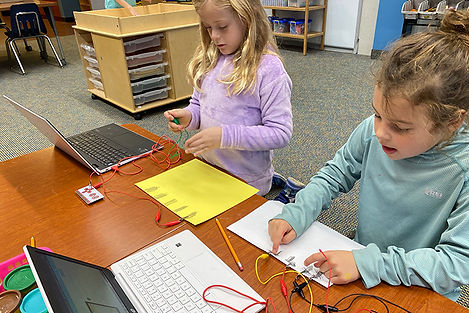
ELEMENTARY SCHOOL
Kindergarten to 5th Grade at Eagle Creek Academy
The Advantages of Small Class Sizes
Learning at the Right Level
-
Each K-5 class has up to 16 students.
-
Even within our small classes, we separate the children into smaller groups for focused learning activities. For example, our kindergarten teacher works independently with several math groups.
-
Since our classes are small, the teachers spend a lot of time with each small group and each child.
-
With such small groups, we can give different assignments to different children depending on their abilities. For example, in one classroom, we may be using several different spelling lists.
-
Because we work with the children at their personal levels, they learn concepts more quickly and internalize them more deeply.

Learning with a Customized Plan
-
We plan our lessons and activities to meet each child's strengths and needs. For example, if we know a child is strong in technology but struggling with writing, we may offer that child the option to create a digital tri-fold flyer about his favorite subject. This allows the child to use his strengths to aid his learning.
-
We communicate often with parents to identify growth and plan our next steps. Parents often share suggestions that help us help their children. With a limited number of children assigned to each teacher, the teachers have plenty of time to hear your ideas.
-
With our approach, the children learn to think about their learning and manage it along with us. This helps them gain true self-confidence.

Learning by Asking and Answering
-
We teach with an inquiry-based approach.
-
This approach motivates children to ask solid questions and find in-depth answers.
-
For example, to teach the fifth-grade unit on how eyes work, we start off with activities that show us what we already know about eyes. This leads the children to ask excellent questions which they look forward to researching.
-
By teaching the children to pose questions and find answers, they not only learn the content better, but they also learn to read and write beyond all expectations.
-
With small groups, the teachers have plenty of time to guide each child in identifying his or her questions and answers.

Learning by Doing
-
With small groups, we can implement many hands-on activities.
-
For math, at all age levels, we use hands-on tools, games, and projects, so the children can process how math works.
-
In science, we do experiments first and hold the discussions after, so the children can discover the properties of science for themselves.
-
When children are active like this, they learn and remember everything better. They also care more, which motivates them to jump into the next lessons.

Learning by Moving Up
-
From kindergarten through fifth grade, we spend at least 50 minutes on math each day.
-
This gives the children a lot of time to learn and practice new skills right here at school.
-
With our small groups, the teachers always have the chance to help each child independently.
-
Advanced students may work in a high group in their classroom, or they may work with the children in the next grade up.



